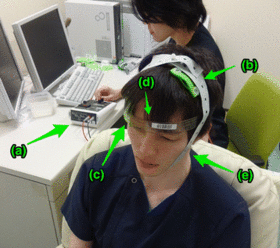
Back تنبيه باستخدام تيار مباشر عبر القحف Arabic Transkraniální stimulace stejnosměrným proudem Czech Transkranielle Gleichstromstimulation German Estimulación transcraneal con corriente directa Spanish تحریک جریان مستقیم درونجمجمهای Persian Aivojen tasavirtastimulaatio Finnish Stimulation transcrânienne à courant direct French Przezczaszkowa stymulacja prądem stałym Polish Estimulação transcraniana por corrente contínua Portuguese Микрополяризация Russian
| Transcranial direct-current stimulation | |
|---|---|
 Anodal tDCS administration. Anodal (b) and cathodal (c) electrodes with 35 cm2 size are put on F3 and right supraorbital region, respectively. A head strap is used (d) for convenience and reproducibility, and a rubber band (e) for reducing resistance. | |
| MeSH | D065908 |
Transcranial direct current stimulation (tDCS) is a form of neuromodulation that uses constant, low direct current delivered via electrodes on the head. It was originally developed to help patients with brain injuries or neuropsychiatric conditions such as major depressive disorder. It can be contrasted with cranial electrotherapy stimulation, which generally uses alternating current the same way, as well as transcranial magnetic stimulation.[1]
Research shows increasing evidence for tDCS as a treatment for depression.[2][3][4] There is mixed evidence about whether tDCS is useful for cognitive enhancement in healthy people. There is no strong evidence that tDCS is useful for memory deficits in Parkinson's disease and Alzheimer's disease,[5] non-neuropathic pain,[6] nor for improving arm or leg functioning and muscle strength in people recovering from a stroke.[7] There is emerging supportive evidence for tDCS in the management of schizophrenia – especially for negative symptoms.[8][9]
- ^ Rosa MA, Lisanby SH (January 2012). "Somatic treatments for mood disorders". Neuropsychopharmacology. 37 (1): 102–116. doi:10.1038/npp.2011.225. PMC 3238088. PMID 21976043.
- ^ Cite error: The named reference
Brunoni2016was invoked but never defined (see the help page). - ^ Cite error: The named reference
Mutz2019was invoked but never defined (see the help page). - ^ "Transcranial direct current stimulation (tDCS) for depression". The National Institute for Health and Care Excellence (NICE). UK. August 2015. Retrieved 10 November 2015.
- ^ Cite error: The named reference
Bennabi2014revwas invoked but never defined (see the help page). - ^ Cite error: The named reference
LuedtkePain2012was invoked but never defined (see the help page). - ^ Elsner B, Kugler J, Pohl M, Mehrholz J (November 2020). "Transcranial direct current stimulation (tDCS) for improving activities of daily living, and physical and cognitive functioning, in people after stroke". The Cochrane Database of Systematic Reviews. 2020 (11): CD009645. doi:10.1002/14651858.CD009645.pub4. PMC 8095012. PMID 33175411.
- ^ Liu Y, Gu N, Cao X, Zhu Y, Wang J, Smith RC, Li C (February 2021). "Effects of transcranial electrical stimulation on working memory in patients with schizophrenia: A systematic review and meta-analysis". Psychiatry Research. 296: 113656. doi:10.1016/j.psychres.2020.113656. PMID 33360429. S2CID 229367754.
- ^ Valiengo LD, Goerigk S, Gordon PC, Padberg F, Serpa MH, Koebe S, et al. (February 2020). "Efficacy and Safety of Transcranial Direct Current Stimulation for Treating Negative Symptoms in Schizophrenia: A Randomized Clinical Trial". JAMA Psychiatry. 77 (2): 121–129. doi:10.1001/jamapsychiatry.2019.3199. PMC 6802484. PMID 31617873.
© MMXXIII Rich X Search. We shall prevail. All rights reserved. Rich X Search